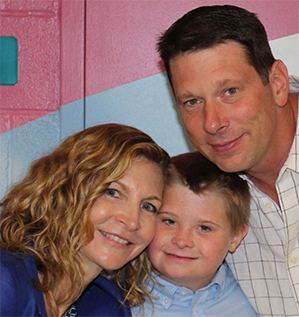Parents Turn to Prozac to Treat Down Syndrome
When Southwest Airlines pilot Paul Watson lands in a new city, he often strikes out to visit the labs of local scientists studying Down syndrome. He likes to stay current because his 14-year-old son, Nathan, has the condition.

And Watson can take some credit for one idea spreading among parents: that the drug fluoxetine, also known as Prozac, might actually treat Down syndrome.
After reading about studies on mice that found positive effects from treatment with the blockbuster antidepressant, Watson got a prescription for his son, who has been taking the drug for three years. “Nathan is doing pretty well cognitively,” says Watson, who lives in Georgia.
He’s not the only child being given the drug. Parent activists say there are at least 200 children with Down syndrome in the U.S. who are receiving fluoxetine in an attempt to boost their brainpower, and the same is happening overseas. “I know at least 30 people in my circle of friends who have their kids on Prozac,” says Lara Font, who lives near Houston and started her six-year-old son, Parker, on fluoxetine when he was 15 months old.
There’s no cure for Down syndrome and no drug treatment. That’s frustrating to parents. But no one can say if Prozac is working because, so far, research has focused on mice, not humans, and there hasn’t been any clinical trial of the drug’s effectiveness in Down syndrome. Few pharmaceutical companies study any treatments for the disorder.
Through Watson’s advocacy, that is about to change. At the end of this month, doctors at the University of Texas Southwestern Medical Center in Dallas plan to start enrolling 21 pregnant women whose fetuses have been diagnosed with Down syndrome. Fourteen will be chosen at random to take fluoxetine and the others will get a placebo.
After birth, the children will keep taking the pills until they are two years old, and they’ll be evaluated regularly after they’re born via developmental skills assessments and MRI imaging. The study is the first organized trial of fluoxetine to treat Down syndrome and one of the few studies of any drug to treat the condition.
“Other parents whose kids are taking Prozac also feel that their kids are performing ahead of their peers with Down syndrome,” says Watson. “But we don’t really know. That’s why we want a drug trial. We wanted to legitimize it with a formal study.”
The big question is whether Prozac somehow can steer the development of the brain, which in people with Down syndrome is characterized by fewer neurons, a smaller overall size, and lower-than-usual IQ. Down syndrome, also called trisomy 21, is caused by an extra copy of chromosome 21.
The pilot study won’t be large enough to fully answer that question, in part because children with Down syndrome are born with wide differences in cognitive symptoms. But if results are promising, the study might expand to other hospitals, says Carol Tamminga, chair of the psychiatry department at UT Southwestern and head of the study.

Tamminga has a personal interest; she had a sister with Down syndrome who died in her twenties. “Her IQ was perhaps 30,” says Tamminga. A drug that could “help that even moderately” would be a significant advance, she says.
Prozac hit the market in the mid-1980s and became an instant commercial success. Many pregnant women already take the drug if they’re depressed, although it is not without its concerns. Some studies have associated the drug with a small risk of serious lung and heart problems, premature birth, and an increased risk of autism. But others have found no increase in major birth defects.
The idea of administering fluoxetine to treat Down syndrome started to gain currency among parents about 10 years ago after some early laboratory research on animals showed promising results.
Since then, there’s been more evidence the drug could help, particularly a 2014 study, reported in the journal Brain, by Italian researcher Renata Bartesaghi. When she gave fluoxetine to mice whose pups have a rodent version of Down syndrome, the animals were born with a normal number of neurons.
“We counted the number of cells in every single part of the brain in the pups,” says Bartesaghi. “In every part we examined, the number of neurons was normal.”
Watson says he was already giving Nathan fluoxetine when he saw the journal article and sent it to Matt Byerly, a psychiatry professor at UT Southwestern, to pitch the idea of an organized study on kids that could prove whether his decision was the right one.
Byerly, who recently moved to the University of Montana but is still involved in the trial, says when he reviewed what was known about Prozac’s effects on animals he found that seven of eight studies on Down syndrome mouse models had showed benefits from fluoxetine. But Byerly felt the science demanded a prenatal study, not one in children, whose brains are further developed.
“What I found is that there are significant effects evident in the brain by the end of the second trimester and certainly by birth,” says Byerly. “I felt that to take advantage of what fluoxetine could potentially do, we needed to intervene before these changes occur.”
Treating fetuses with any drug is unusual. As a result, says Byerly, the UT study has 14 co-investigators, about three times the usual number, including prenatal specialists and pharmacologists who will monitor what’s happening. In Italy, Bartesaghi says her own request to test the effect of fluoxetine on pregnant women was rejected by an Italian ethics committee, although she is currently testing the drug in some children with Down syndrome.
Fluoxetine works by increasing the availability of serotonin, a neurotransmitter, which plays a role in mood but also in regulating the formation of neurons in the developing brain. By increasing serotonin levels during pregnancy, Bartesaghi and Byerly think, infants with Down syndrome could be born with brains closer to normal.
Other researchers, such as Diana Bianchi of Tufts University Medical School, are hesitant to administer fluoxetine to pregnant women who aren’t depressed, but have also started to search for other drugs that might treat Down syndrome (see “A Change of Mind”).
But Byerly thinks the safety profile of the antidepressant is so well studied that there’s not significant risk. “Why not test it?” he says.
Hundreds of parents have already reached the same conclusion. And a few, like Dominika Kuchta, have even taken the drug during pregnancy. Kuchta, a Polish citizen who lives in the United Kingdom, says she took Prozac in 2014 while pregnant with her son, Tomasz, and after learning from a prenatal test that he’d be born with Down syndrome.
Tomasz, now 21 months, has low muscle tone, which is typical of kids with Down syndrome, but at 18 months he could say “dog,” “apple,” and “bear.”
“He knows that a spoon is for eating, that a hat goes on a head, that a cat goes meow,” says Kuchta, who spends hours teaching him phonics and showing him flash cards. Until the results of UT Southwestern’s study are in, however, Kuchta will have no way of knowing if fluoxetine helped.
“It’s important to know if it’s due to pharmacology or me teaching him,” she says. “My gut feeling is that it is a mix.”
Keep Reading
Most Popular
Large language models can do jaw-dropping things. But nobody knows exactly why.
And that's a problem. Figuring it out is one of the biggest scientific puzzles of our time and a crucial step towards controlling more powerful future models.
The problem with plug-in hybrids? Their drivers.
Plug-in hybrids are often sold as a transition to EVs, but new data from Europe shows we’re still underestimating the emissions they produce.
Google DeepMind’s new generative model makes Super Mario–like games from scratch
Genie learns how to control games by watching hours and hours of video. It could help train next-gen robots too.
How scientists traced a mysterious covid case back to six toilets
When wastewater surveillance turns into a hunt for a single infected individual, the ethics get tricky.
Stay connected
Get the latest updates from
MIT Technology Review
Discover special offers, top stories, upcoming events, and more.